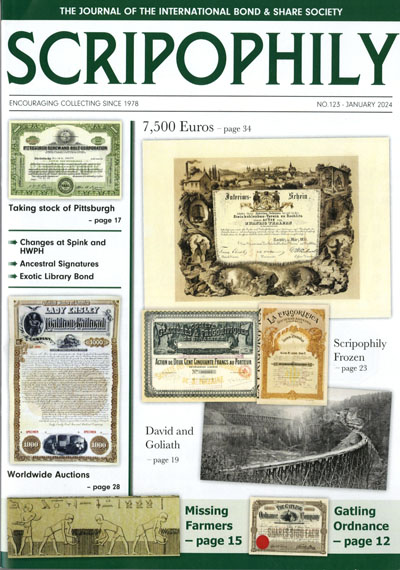
This article appeared in
SCRIPOPHILY
January, 2024
Scripophily is a member benefit of
the International Bond & Share Society.
Visit the IBSS website for info.
Status of the Coxrail Coal Database
I began collecting information about scripophily from North American coal companies early in 2012. I initially wanted to determine the potential scale of the project and how much extra work it might add on top of the railroad database project.
By the end of that year I had compiled 1,076 certificate varieties from 935 companies, mainly from old auction catalogs and dealer websites. I decided the project was a “go” but kept the project to myself for a couple years. Once I alerted contributors to the additional specialty, contributions from contributors, formal auctions, and eBay added 219 new varieties during 2016. That year turned out to be the largest single-year growth spurt and ended with 1,702 varieties from 1,305 companies.
Growth over the next three years (2017-2019) netted an average of 187 new varieties per year and then dropped precipitously. Reports from all sources added an average of only 80 new varieties per year over the next three years (2020-2022). 2023 ended with the lowest certificate growth so far: only 49 new varieties from 37 new companies.
At the end of 2023, the number of certificate varieties from North American coal companies stood at 2,552 representing 1,893 companies. Growth in new coal certificates slowed to only 2%. The railroad database is about 20 years more mature than the coal database, so its growth was only 0.7% in 2023.
By comparison to the railroad database, we have a LONG way to go in compiling serial numbers and pricing history for coal certificates. About a quarter of all railroad serial numbers are uncancelled, suggesting railroads failed frequently. By its nature, coal mining is not terribly profitable and companies were much smaller. Failures were necessarily higher and serial numbers bear that out with almost two-thirds of all coal certificates uncancelled.
Based on contributions and correspondences to this project, it appears there are far fewer collectors interested in the coal mining specialty. Considering the apparent rarity, certificate prices remain highly affordable.
One of the things to notice with coal company scripophily is the generally small sizes of coal companies. The lowest capitalization I’ve seen was only $1,000. Many companies had capitalizations of $10,000 and less. I mention low capitalizations because those kinds of companies were so stressed for operating funds that customized stocks and bonds were an unnecessary luxury. A quarter of all coal company certificates are generic designs, and most of those came from Goes Lithographing Company of Chicago. In fact, Goes’ certificates even outnumber American Bank Note Company certificates. I know collectors find Goes’ certificates boring and repetitive, so I advise thinking about their rarity instead.
The only way I have of measuring rarity is the number of serial numbers recorded. With an average of only 3.3 serial numbers per variety recorded over a period of eleven years, coal company certificates, as a group, are uncommon. Looking a little deeper, we find that almost two-thirds (!) of all coal company certificates are represented by only ONE serial number. We can assume, or at least hope, that level of rarity will soften as more certificates are reported. A specialty with such a high percentage of unique certificates will never generate much interest when so many varieties are unobtainable.
I have recorded only a little more than 14,200 references to stocks and bonds in the coal company database. Appearances on eBay account for a whopping 40% of those. That means recorded prices are pitifully low compared to rarity. Thankfully, collectors report prices also, but not a large number. Consequently, I always need to adjust my estimated prices upward in order to keep expectations in the range of prices likely encountered with professional sellers and auction houses.
That is not to say there have not been several unexpectedly robust sales on eBay, possibly because many items are simply not findable elsewhere. With the exception of numerous stock certificates from mines that operated in the Pennsylvania anthracite fields, prices for items dated in the 1850s to 1870s are strong. Prices for those with custom vignettes seem especially good. Conversely, Goes’ certificates dated in the 1910s and 1920s rarely fetch more then $25 on eBay, regardless of whether they are the first known or not.
I hope there are at least a few readers who collect coal company scripophily and I hope they will contact me with scans, photos, and prices paid. Collectors of all levels are welcome and appreciated. A fully revised Coxrail.com website will launch in late January and the coal database will have its own starting page separate from railroads. Please contact me at tcox@coxrail.com. When you check out the new site, be sure to report every mistake and problem you spot, no matter how trivial.